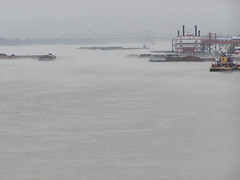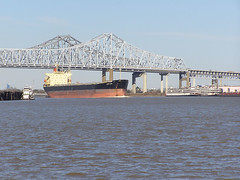The Mississippi carries the most trade of any river in the world. I am most familiar with the upper reaches of the big river in Minnesota and Wisconsin, where barges are common enough. But after seeing the traffic on the river between New Orleans and Baton Rouge I now understand what it means to say that the Mississippi is the busiest river in the world.
Outside Baton Rouge the barges were lined up by dozens, with towboats idling and waiting for a signal to head out to some depot rendezvous. Some of the tows were moving up or down, but most were just parked along the banks, forming nearly a solid line for miles. In some places on the upper river there are hundreds of barges tied up along the banks, but these here were all in active service and ready to move.
Perhaps there is some lower river traffic service that coordinates which tows should head up or down in midstream. Because, even as large as the barges are, there are even bigger boats at play in the river down here.
Enormous ocean-going vessels charged upstream at furious speeds, even against the strong river current. Definitely not something to get in the way of, even for the big towboats.
Long ago the river had been a promenade of sugar plantations lining the banks, each with their Big House in a prominent place fronting the river and rows of slave houses and sugar cane fields stretching back away from the river. The high ground along the levee was a narrow strip of civilization running along both sides of the river where the wealthy built their homes and the poor made due with the swamplands behind.
In antebellum times this area was the wealth and prestige of the Louisiana economy, where sugar barons made their murky fortunes off the exploited and then retired to New Orleans for a life of leisure society.
Many of the plantation homes are preserved as museum homes to tell the old history of the area. But the sugar fields remain behind them, scattered with small communities of sharecropper cabins. Nowadays the sugar cane is harvested by machine, an industrial endeavor.
And in places where there had once been plantations there are now enormous industrial complexes. Oil refineries, chemical plants, railroad yards. No one lives in these places, but they provide jobs and money for Louisiana. And the reason they are here is because of the river. Those ocean-going ships and river barges bring in the raw materials and take away the bulk cargo. Oil from the nearby Gulf powers the process, and river water cools the engines and takes away the effluent.
The famous engineer James Eads built a set of jetties at the mouth of the Mississippi in 1879, which forced the current of the river to scour the sandbars that had once obstructed traffic entering the river from the sea. It was a boon to New Orleans, and fueled its growth to become the second-busiest port in the US.
But the jetties and the levees built after the great 1927 flood have turned the river from a sprawling delta network of interconnected channels to a narrow conduit of fast moving effluent and trade. The floodwaters that once built the delta land with silt are now directed quickly downstream to keep the flow of boat traffic flowing and wheels of industry humming and the swamplands that protected New Orleans from ocean hurricane surges have been sinking and disappearing since then. Only recently has a plan been released by the Army Corps of Engineers to release some river water again to rebuild the lands around the city.
Standing on the rubbly banks of the river at Baton Rouge, one sees a busy highway of industry, cut off from the network of rich swamplands behind the levees. There is no room here for fishermen or small boats here among the diesel giants, and the water is probably too polluted for much human contact anyway. But the delta is dying without the nourishing waters of this river, and one can only hope that reuniting the bayous and the river will replenish and revitalize both, without smothering all in pollution.






